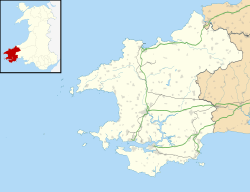RAF Pembroke Dock
| RAF Pembroke Dock | |
|---|---|
| Pembroke, Pembrokeshire | |

A Fokker T-VIIIW seaplane of No. 320 (Dutch) Squadron RAF, attended by Dutch Naval groundcrew, being taken down to the water on a carrier at Pembroke Dock, Pembrokeshire
|
|
|
Shown within Pembrokeshire
|
|
| Coordinates | 51°41′44″N 04°57′11″W / 51.69556°N 4.95306°WCoordinates: 51°41′44″N 04°57′11″W / 51.69556°N 4.95306°W |
| Type | Seaplane and Flying boat station |
| Code | PM |
| Site information | |
| Owner |
Air Ministry Ministry of Defence |
| Controlled by |
Royal Air Force - Coastal Command |
| Open to the public |
Limited – now a ferry terminal |
| Site history | |
| Built | 1930 |
| In use | 1930–1959 |
| Battles/wars | Battle of the Atlantic |
| Garrison information | |
| Past commanders |
Sir Arthur Harris(as Wg Cdr) |
Royal Air Force Pembroke Dock or more simply RAF Pembroke Dock was a Royal Air Force Seaplane and Flying Boat station located at Pembroke Dock, Pembrokeshire, Wales. The Royal Navy contingent left in 1926 with the Royal Air Force occupying the site from 1 January 1930. During the initial stages of the Second World War, it became the home of two Dutch flying boats and their squadron personnel as well as hosting RAF, Fleet Air Arm, Canadian, Royal Australian Air Force and United States naval crews.
It became the largest Flying Boat station in the world and at one point during the Second World War it was host to 99 aircraft.
The station badge showed a Manx Shearwater bird on one of the many islands that lie off the eastern Pembrokeshire coastline. The motto was in Welsh; Gwylio'r gorooewin o'r awyr which translates into English as "To watch the west from the air". The badge was approved and issued in January 1948.
Despite the Royal Navy abruptly withdrawing from Pembroke Dock in 1926, the haven along the Daugleddau estuary had been used by seaplanes of the Royal Naval Air Service and the Royal Air Force before a permanent seaplane air base was established. The Royal Air Force arrived in Pembroke Dock on 1 January 1930 with the first Squadron (No 210) arriving in June 1931. Throughout the 1930s, No 210 Squadron was the main Squadron operating from RAF Pembroke Dock and was equipped firstly with Supermarine Southamptons, Short Rangoons and Short Singapore IIIs.
The base was located on the south side of the estuary opposite the town of Milford Haven. The base was on a promontory which restricted space for buildings due to the local housing in the area.
Initially, the seaplane service only operated and carried out maintenance from a specially adapted floating dock known as HMS Flat Iron. This floating dock was able to submerge and allow two seaplanes to navigate onto it and then raise itself back up to allow for complex maintenance. During the 1930s the Royal Air Force improved RAF Pembroke Dock by the installation of two 'B' and one 'T' hangar and in 1938, the floating dock was towed to Invergordon as it was redundant. In 1935, the first spillway was constructed which allowed aircraft to be removed from the water whatever the tide. During this period, Sir Arthur Travers Harris (Bomber Harris) was the Officer Commanding RAF Pembroke Dock and 210 Squadron as a Wing Commander.
...
Wikipedia

